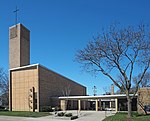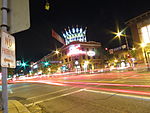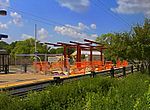Longfellow is a defined community in Minneapolis, Minnesota which includes five smaller neighborhoods inside of it: Seward, Cooper, Hiawatha, Howe and Longfellow. The community is a mix of agri-industrial properties along the old Northern Pacific Railway, expansive parkland surrounding the famous Minnehaha Falls, and smaller residential areas.
The community is grouped with South Minneapolis between the city's eastern border with the Mississippi River and the Metro Blue Line, Longfellow takes its name from Longfellow neighborhood which in turn is named after Henry Wadsworth Longfellow. The renowned American poet incorporated elements into his poem The Song of Hiawatha from Henry Schoolcraft's accounts of native Dakota lore in Minnesota which included Minnehaha Falls in Longfellow's southern tip. The early reference of Highway 55 as Hiawatha Avenue, along the west border, may have influenced the naming decision when community borders were drawn in the 1960s. Hiawatha Avenue is the main thoroughfare leading north into Downtown Minneapolis and south to the Minneapolis-Saint Paul Airport.
Longfellow is home to the Danish American Center, Minnehaha Academy, Christ Church and the Longfellow House. The area is typically recognized by bungalow style Craftsman homes built in the 1920s. However it also contains the Ray and Kay Price House, designed by the famed Ralph Rapson, and the Frederick Lang House, designed by Herb Fritz. Minnehaha Falls is a national attraction and an important cultural node of the Twin Cities. The neighborhood's central corridor runs along 42nd Avenue South and is home to many businesses including the Riverview Theater, Turtle Bread Company, The Blue Door Pub and Mother Earth Gardens. Along the northern edge runs the Midtown Greenway trail and the vibrant East Lake business district, which is home to many award winning restaurants including Town Talk Diner, Sonora Grill, and The Bungalow Club. The west border was once an agri-industrial and milling processing center served by the Northern Pacific Railway. Today the grain silos and factories along the length of the highway are set to make way for new residential condos, apartment buildings, and a new greenway connecting Minnehaha Falls and the Midtown Greenway. This area is also anchored by the Minnehaha Mile, a biking street that contains more antique, vintage, retro, and secondhand shops than any other commercial corridor in the state of Minnesota











